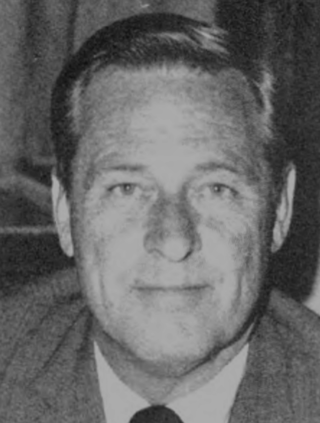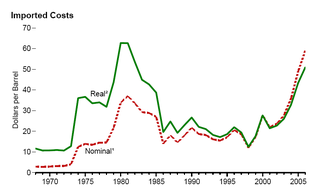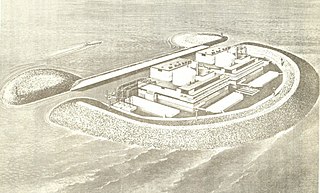Related Research Articles

The United States Department of Energy (DOE) is an executive department of the U.S. federal government that oversees U.S. national energy policy and energy production, as well as manages the research and development of nuclear power, the military's nuclear weapons program, nuclear reactor production for the United States Navy, energy-related research, and energy conservation.
This section of the timeline of United States history concerns events from 1970 to 1989

In October 1973, the Organization of Arab Petroleum Exporting Countries (OAPEC) announced that it was implementing a total oil embargo against the countries who had supported Israel at any point during the Fourth Arab–Israeli War, which began after Egypt and Syria launched a large-scale surprise attack in an ultimately unsuccessful attempt to recover the territories that they had lost to Israel during the Third Arab–Israeli War. In an effort that was led by Faisal of Saudi Arabia, the initial countries that OAPEC targeted were Canada, Japan, the Netherlands, the United Kingdom, and the United States. This list was later expanded to include Portugal, Rhodesia, and South Africa. In March 1974, OAPEC lifted the embargo, but the price of oil had risen by nearly 300%: from US$3 per barrel ($19/m3) to nearly US$12 per barrel ($75/m3) globally. Prices in the United States were significantly higher than the global average. After it was implemented, the embargo caused an oil crisis, or "shock", with many short- and long-term effects on the global economy as well as on global politics. The 1973 embargo later came to be referred to as the "first oil shock" vis-à-vis the "second oil shock" that was the 1979 oil crisis, brought upon by the Iranian Revolution.
An energy crisis or energy shortage is any significant bottleneck in the supply of energy resources to an economy. In literature, it often refers to one of the energy sources used at a certain time and place, in particular, those that supply national electricity grids or those used as fuel in industrial development. Population growth has led to a surge in the global demand for energy in recent years. In the 2000s, this new demand – together with Middle East tension, the falling value of the US dollar, dwindling oil reserves, concerns over peak oil, and oil price speculation – triggered the 2000s energy crisis, which saw the price of oil reach an all-time high of $147.30 per barrel ($926/m3) in 2008.

A drop in oil production in the wake of the Iranian Revolution led to an energy crisis in 1979. Although the global oil supply only decreased by approximately four percent, the oil markets' reaction raised the price of crude oil drastically over the next 12 months, more than doubling it to $39.50 per barrel ($248/m3). The sudden increase in price was connected with fuel shortages and long lines at gas stations similar to the 1973 oil crisis.

The Bataan Nuclear Power Plant (BNPP) is a nuclear power plant on the Bataan Peninsula, 100 kilometers (62 mi) west of Manila, Philippines. Completed but never fueled, it is located on a 3.57 km2 (1.38 sq mi) government reservation at Napot Point in Morong, Bataan. It was the Philippines' only attempt at building a nuclear power plant. It was mothballed due to safety concerns in the wake of the Chernobyl disaster in Ukraine in 1986 and issues regarding corruption. The Letter of Instruction No. 957, s. 1979 was signed by the late President Ferdinand Marcos and was published on November 13, 1979, in which it states that the continuation of the construction was not possible due to potential hazards to the health and safety of the public; however, the Marcos administration eventually supported the project.

United States energy independence is the concept of eliminating or substantially reducing import of petroleum to satisfy the nation's need for energy. Some proposals for achieving energy independence would permit imports from the neighboring nations of Canada and Mexico, in which case it would be called North American energy independence. Energy independence is espoused by those who want to leave the US unaffected by global energy supply disruptions and would restrict reliance upon politically unstable states for its energy security.

Energy security is the association between national security and the availability of natural resources for energy consumption. Access to cheaper energy has become essential to the functioning of modern economies. However, the uneven distribution of energy supplies among countries has led to significant vulnerabilities. International energy relations have contributed to the globalization of the world leading to energy security and energy vulnerability at the same time.

Energy independence is independence or autarky regarding energy resources, energy supply and/or energy generation by the energy industry.

John Arthur Love was an American attorney and Republican politician who served as the 36th Governor of the State of Colorado from 1963 to 1973.

The Japan Crude Cocktail (JCC) is the informal nickname given to the pricing index of Crude Oil used in most East Asian countries. The JCC is the average price of customs-cleared crude oil imports into Japan and is published by the Petroleum Association of Japan. The official name of the JCC is the Japan Customs-cleared Crude Oil Price. The valuation of the JCC closely reflects the market state of supply and demand. Clear fluctuations in JCC pricing can be linked to distinct events such as the 2007-08 Global Financial Crisis and the 2011 Fukushima Disaster.

Juragua Nuclear Power Plant was a nuclear power plant under construction in Cuba when a suspension of construction was announced in 1992 following the collapse of the Soviet Union and the termination of Soviet economic aid to Cuba. Russia and Cuba sought third-country financing to complete the plant in the mid-1990s but in 2000 the two countries agreed to abandon the project.

Energy in Armenia is mostly from natural gas. Armenia has no proven reserves of oil or natural gas and currently imports most of its gas from Russia. The Iran-Armenia Natural Gas Pipeline has the capacity to equal imports from Russia.

The 1970s energy crisis occurred when the Western world, particularly the United States, Canada, Western Europe, Australia, and New Zealand, faced substantial petroleum shortages as well as elevated prices. The two worst crises of this period were the 1973 oil crisis and the 1979 energy crisis, when, respectively, the Yom Kippur War and the Iranian Revolution triggered interruptions in Middle Eastern oil exports.

Offshore Power Systems (OPS) was a 1970 joint venture between Westinghouse Electric Company, which constructed nuclear generating plants, and Newport News Shipbuilding and Drydock, which had recently merged with Tenneco, to create floating nuclear power plants at Jacksonville, Florida.

Nuclear Energy was considered as an alternative source of energy after the 1973 oil crisis, in which the Philippines was affected. The Bataan Nuclear Power Plant was built in the early 1980s as a result, but never went into operation. It was mothballed by Former President Corazon Aquino on the fear of reactor meltdown after the Chernobyl Disaster as well as the increase of the price of the plant. The Fukushima nuclear disaster dampened further efforts to revive nuclear energy in the philippines and gave pause to efforts to revive the plant.
The Federal Energy Administration (FEA) was a United States government organization created in 1974 to address the 1970s energy crisis, and specifically the 1973 oil crisis. It was merged in 1977 with the Energy Research and Development Administration (ERDA) into the newly created United States Department of Energy.
This is a history of nuclear power as realized through the first artificial fission of atoms that would lead to the Manhattan Project and, eventually, to using nuclear fission to generate electricity.
The US foreign policy during the presidency of Richard Nixon (1969–1974) focused on reducing the dangers of the Cold War among the Soviet Union and China. President Richard Nixon's policy sought on détente with both nations, which were hostile to the U.S. and to each other in the wake of the Sino-Soviet split. He moved away from the traditional American policy of containment of communism, hoping each side would seek American favor. Nixon's 1972 visit to China ushered in a new era of U.S.-China relations and effectively removed China as a Cold War foe. The Nixon administration signed the Anti-Ballistic Missile Treaty with the Soviet Union and organized a conference that led to the signing of the Helsinki Accords after Nixon left office.

Anti-nuclear protests in the United States have occurred since the development of nuclear power plants in the United States. Examples include Clamshell Alliance protests at Seabrook Station Nuclear Power Plant, Abalone Alliance protests at Diablo Canyon Power Plant, and those following the Three Mile Island accident in 1979.
References
- ↑ Nixon, Richard (1973-11-07). "Address to the Nation About Policies To Deal With the Energy Shortages". The American Presidency Project. Archived from the original on 2022-04-18. Retrieved 2022-09-04.
- ↑ James Laxer (1975). Canada's energy crisis . Toronto: James Lorimer & Company. p. 41. ISBN 0-88862-087-X.
- 1 2 Charles E. Brown (2002). World energy resources. New York: Springer. p. 227. ISBN 3-540-42634-5.
- ↑ U.S. Department of Energy. "Energy Timeline: from 1971 to 1980". Archived from the original on July 21, 2011. Retrieved 2012-03-01.
{{cite web}}: CS1 maint: unfit URL (link) - ↑ John Adams, Transport planning, vision and practice, (1981), p.72